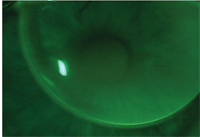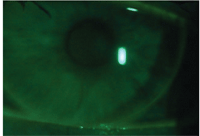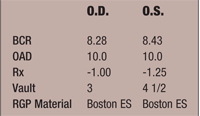 Refractive surgery will always intrigue those with significant refractive errors. The obvious enticement is the ability to see without the need for spectacles or contact lenses. Optimal results offer patients these advantages post-operatively, but sub-optimal results often times mean very different visual outcomes. It is a true ironic twist that patients who select refractive surgery to eliminate contact lens wear may find that lens wear is the best tool practitioners have to optimize poor refractive surgery results. When the procedure doesn’t create ideal results, these patients may be left with residual refractive errors, irregular corneas and decreased best-corrected visual acuity.
Refractive surgery will always intrigue those with significant refractive errors. The obvious enticement is the ability to see without the need for spectacles or contact lenses. Optimal results offer patients these advantages post-operatively, but sub-optimal results often times mean very different visual outcomes. It is a true ironic twist that patients who select refractive surgery to eliminate contact lens wear may find that lens wear is the best tool practitioners have to optimize poor refractive surgery results. When the procedure doesn’t create ideal results, these patients may be left with residual refractive errors, irregular corneas and decreased best-corrected visual acuity.
What RK Patients May Face
The popular radial keratectomy (RK) offered many patients the freedom from glasses and contact lenses. But for those with sub-optimal results, RK created significant frustrations. One persistent complaint was nighttime glare, where the pupils enlarge in dim illumination which places the RK scars within the pupil. Anecdotally, we have prescribed topical brimonidine to leverage its ability to keep the pupil constricted because of its alpha-1 adrenergic receptor activity, thus minimizing the glare.
Some patients who have had RK now suffer from significant anisometropia—so much so that it makes wearing glasses for these patients very difficult. Others will have significant refractive shifts because of unstable corneas. This creates a difficult situation when trying to optimally correct vision for these patients.
Many of the same type of challenges can be seen with patients who have had suboptimal LASIK or PRK results.
Contact Lens Complications

1. A 14.0mm large diameter RGP showing central pooling on a post-RK patient.
If patients wore soft contact lenses pre-operatively, they often expect to also be able to wear them post-operatively if they require residual refractive correction. For some, this is true but for others, it is difficult to maintain stable vision because of the post-operatively altered corneal architecture. The central flattened cornea is sometimes difficult for soft lenses to conform to and will at times lead to the lens vaulting the cornea. This will inherently lead to visual instability between blinks.
Rigid gas permeable (RGP) lenses may be the best option for these patients, but they may also be difficult to fit on irregularly shaped corneas. If the RGP is fit to the post-operative keratometry readings, it will be too flat because of the poor interaction with the midperipheral and peripheral cornea. If the RGP is fit utilizing pre-operative keratometry readings, central fluorescein pooling will be evident and much of the support of the lens will be on the mid-peripheral and peripheral cornea.
We have had success fitting some of our post-operative refractive surgery patients who require additional refractive correction with a large diameter, high Dk RGP, such as SO2Clear. These lenses rest on the bulbar conjunctiva and while they show some central pooling, they do not place undue stress on peripheral cornea like a more traditional spherical gas permeable lens would (see figure 1).
Reverse Geometry Lenses

2. The reverse geometry RGP is a loose fit demonstrating a superior nasal fit (left).
Patients with post-operative refractive surgery corneas certainly have challenges because of the central flattening of their corneas. These patients can be fit remarkably successfully with reverse geometry lenses. Although they are available in both soft and RGP designs, we will limit our discussion in this article to the RGP.
This design is unique in that the profile of the posterior surface of the lens will resemble the profile of the cornea with a flatter central curve and a steeper peripheral curve. These lenses are typically fit slightly larger than traditional RGPs (10.0mm vs. 9.0mm to 9.6mm). Although the curve of the central portion of the contact lens will affect certain fit characteristics of the lens on the eye, the reverse curve on the lens may be just as important. Typical fitting strategies for this lens include selecting the initial base curve based on the keratometry readings and then modifying fit characteristics by either tightening or loosening the reverse curve on the lenses.
The goal is to have a relative alignment fit centrally and peripherally without excessive bearing in any areas of the cornea. There will likely be a fine midperipheral ring of fluorescein accumulation representing the rapid change in the curve of the lens. Lenses that are fitting loose can initially be steepened in the periphery and if they are still fitting loose, can then be steepened centrally (see figure 2). Lenses that are too tight can initially be flattened peripherally and then, if still fitting too tight, can be loosened centrally.
Essentially, the strategy is to initially manipulate the peripheral curves to try to modify the fit. If after these curves have been altered the fit is still unacceptable, then change the central base curve. Although these can be empirically ordered, it is recommended to invest in a reverse geometry fitting set. This way the fit can be optimized and an accurate over-refraction can be performed at the first visit.

A reverse geometry RGP on
the same patient after steepening the central and peripheral curves
(right). Notice the better centration of the right lens compared to the
left one.
A Case Study
A 38-year-old female patient with a history of RK (8-cut) and AK (2-cut) surgery O.D. and O.S. presented for a comprehensive eye exam and contact lens fitting. Of importance, her RK and AK scars were distorted and wavy in both eyes. Her MR was +2.00-2.25x002 O.D. and +4.00-3.00x169 O.S. post-operatively after unsuccessful refractive procedures O.U. Topography revealed a very flat central cornea (37.00D) progressing to a steeper peripheral cornea (46.00D) in some areas. Her corneas were very irregular, resulting in best-corrected visual acuities of 20/20- O.D. and 20/30+ O.S.
She also presented with a history of unsuccessful contact lens wear. She reported trying custom soft toric lenses, which she reported would not stabilize. She described her vision through the lenses as being distorted with large amounts of haloes and shadowing. She also complained of poor comfort and could only wear those lenses for about four to six hours at the most.
The challenges in fitting the patient with contact lenses along with all associated fees were clearly discussed. I recommended reverse geometry RGPs for this patient. She had worn RGPs prior to having RK and agreed that they may provide her with the best vision. After consulting with my RGP lab and utilizing a fit set in office, I ordered the lenses (see figure 3).
 The vault curve values are independent of corneal curvature and are fit via elevation or height rather than base curve. Utilizing a fitting set is important to determine appropriate vault. At the patient’s follow-up visit, she mentioned a “much improved vision” and was correctable to 20/20+ O.D. and 20/20 O.S.
The vault curve values are independent of corneal curvature and are fit via elevation or height rather than base curve. Utilizing a fitting set is important to determine appropriate vault. At the patient’s follow-up visit, she mentioned a “much improved vision” and was correctable to 20/20+ O.D. and 20/20 O.S.
Reverse geometry lenses enhance patient comfort, improves centration and visual acuity for those with suboptimal refractive surgery outcomes. For these reasons, reverse geometry RGP design makes this contact lens ideal for patients who have previously failed in lens wear due to their irregular corneas secondary to subpar refractive surgery outcomes.


